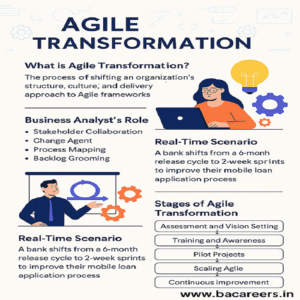In today’s fast-paced digital world, change is the only constant. Businesses must be flexible, innovative, and responsive to customer needs. To keep up, many organizations are moving away from rigid traditional methods and embracing Agile Transformation.
But Agile Transformation is more than just using Scrum or holding daily stand-ups. It’s a cultural, organizational, and mindset shift—a journey that impacts people, processes, and technologies.

In this comprehensive guide, you’ll learn:
What Agile Transformation is
Why it’s important
Real-time examples
The role of a Business Analyst in Agile Transformation
Key steps, benefits, tools, and challenges
Helpful internal and external resources
✅ What is Agile Transformation?
Agile Transformation is the process of shifting an organization’s structure, culture, and delivery approach from traditional (usually Waterfall) methods to Agile frameworks like Scrum, SAFe, Kanban, or a custom Agile approach.
It’s not just about training teams or hiring Scrum Masters—it’s about transforming the entire mindset and behavior of how work is planned, executed, and delivered.
🔹 Key Components of Agile Transformation:
Cultural shift toward collaboration, trust, and flexibility
Structural change (e.g., self-organizing teams, flatter hierarchies)
Process redesign using Agile frameworks
Tool adoption (e.g., Jira, Confluence, Azure DevOps)
Leadership support for Agile principles
📌 Internal Link: Learn more about Agile Methodology for Business Analysts
🧠 Why Do Organizations Undergo Agile Transformation?
Organizations pursue Agile Transformation to:
Deliver products faster and more efficiently
Adapt to market changes quickly
Improve customer satisfaction
Enhance team collaboration
Increase innovation and reduce risk
🔍 Real-Time Scenario:
A traditional insurance company faces declining market share due to faster, tech-driven competitors. They initiate Agile Transformation to develop digital products more quickly. Instead of yearly releases, they shift to monthly Agile sprints, allowing faster testing and customer feedback.
🔄 Agile Transformation vs. Agile Adoption
| Agile Adoption | Agile Transformation |
|---|---|
| Often team-level | Organization-wide |
| Focuses on tools and processes | Involves culture, leadership, structure |
| Short-term | Long-term journey |
| Might be partial or experimental | Strategic and fully committed |
📊 Stages of Agile Transformation
Agile Transformation is a step-by-step journey, not a one-time event.
1. Assessment and Vision Setting
Evaluate current maturity level
Define clear vision and goals
2. Training and Awareness
Conduct Agile workshops and bootcamps
Educate leadership, BAs, PMs, developers
3. Pilot Projects
Begin with small teams to test Agile
Select cross-functional teams
4. Scaling Agile
Implement frameworks like SAFe or LeSS for multiple teams
Standardize Agile practices
5. Continuous Improvement
Regular retrospectives
Agile coaching and mentoring
📘 Related Reading: Business Analyst Role in Agile Scrum
👩💼 Business Analyst’s Role in Agile Transformation
During Agile Transformation, the Business Analyst (BA) plays a pivotal role in bridging the gap between business needs and technical solutions.
💼 Key Responsibilities:
Stakeholder Collaboration: Help stakeholders understand Agile values
Change Agent: Promote Agile mindset through training and advocacy
Process Mapping: Redesign business processes to fit Agile
Backlog Grooming: Collaborate with Product Owners to build and refine product backlogs
Data-Driven Decisions: Use metrics and insights to guide transformation efforts
📌 Real-Time Example:
A BA in a large retail chain helps the company switch from monthly waterfall releases to 2-week sprints. They work closely with business teams to write user stories, train stakeholders on Agile ceremonies, and track KPIs like sprint velocity and defect rate.
📚 Internal Link: Read more on Soft Skills for Business Analyst
💡 Benefits of Agile Transformation
🚀 Faster Time to Market
👥 Enhanced Collaboration and Communication
🛠️ Better Product Quality
📈 Higher Productivity and Morale
🎯 Customer-Centric Delivery
🔁 Increased Flexibility and Innovation
⚙️ Tools Used in Agile Transformation
| Tool | Purpose |
|---|---|
| Jira | Backlog management, sprint planning |
| Confluence | Documentation, knowledge sharing |
| Miro | Visual collaboration, process mapping |
| Azure DevOps | End-to-end DevOps and Agile |
| Slack / MS Teams | Real-time communication |
🔗 External Link: Jira Software by Atlassian
🔍 Real-Time Scenario: Agile Transformation in Banking
A bank with rigid approval systems wants to create a mobile loan application process. Before transformation:
Release cycle = 6 months
Feedback loop = 0
Post Agile Transformation:
Cross-functional teams handle each feature
2-week sprints with working demos
User feedback incorporated every cycle
The BA works closely with loan officers and IT to define features like document upload, real-time credit score checks, and instant notifications—all developed and deployed incrementally.
⚠️ Challenges in Agile Transformation
| Challenge | How the BA Helps |
|---|---|
| Resistance to change | Conduct stakeholder workshops |
| Poor backlog quality | Define clear user stories and acceptance criteria |
| Role confusion | Clarify responsibilities with RACI matrices |
| Lack of leadership buy-in | Present data-driven value metrics |
📏 Metrics to Track Agile Transformation Success
Sprint Velocity
Customer Satisfaction (CSAT)
Lead Time and Cycle Time
Team Engagement Score
Defect Leakage Rate
ROI of Agile Initiatives
📘 Internal Link: Business Analyst Interview Tips for Freshers
🧠 Best Practices for Business Analysts in Agile Transformation
Be a continuous learner—Agile is evolving
Act as a facilitator, not just a requirements gatherer
Encourage collaborative decision-making
Focus on value delivery over process rigidity
Use visual tools like journey maps, wireframes, and storyboards
🔚 Conclusion: Agile Transformation is a Business Evolution
Agile Transformation isn’t about adopting a framework—it’s about transforming how an organization thinks, behaves, and delivers value. It touches every part of the business, from leadership to development teams to operations.
Business Analysts play a crucial role in making this shift successful. Their ability to translate vision into actionable steps, communicate with stakeholders, and facilitate change makes them indispensable in any Agile Transformation journey.
🔗 Internal Links (Further Reading)
🌐 External Resources

Business Analyst , Functional Consultant, Provide Training on Business Analysis and SDLC Methodologies.
